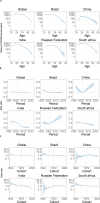Time trends in maternal hypertensive disorder incidence in Brazil, Russian Federation, India, China, and South Africa (BRICS): an age-period-cohort analysis for the GBD 2021
- PMID: 39516729
- PMCID: PMC11545085
- DOI: 10.1186/s12884-024-06931-z
Time trends in maternal hypertensive disorder incidence in Brazil, Russian Federation, India, China, and South Africa (BRICS): an age-period-cohort analysis for the GBD 2021
Abstract
Objectives: Maternal hypertensive disorder (MHD) is a leading cause of significant maternal and fetal mortality and morbidity. The BRICS nations are crucial in the global MHD landscape, given their large populations and varied healthcare infrastructures. This investigation evaluates the incidence trends of MHD in BRICS countries from 1992 to 2021.
Study design and methods: Data on the number, all-age rate, age-standardized rate (ASR), and the relative change of MHD incidence from this study were sourced from the Global Burden of Disease (GBD) 2021 public dataset to investigate temporal trends in MHD incidence over three decades globally and in BRICS countries. The age-period-cohort (APC) model was used to estimate net drift, local drift, age-specific curves, and period (cohort) relative risks.
Results: A 15.87% increase in global MHD cases, alongside a 13.40% decrease in age-standardized incidence rates from 1992 to 2021. MHD incidence rates are declining across various BRICS age groups, except in China and Russian Federation, where most groups exhibit increasing trends. Annual net drift in MHD incidence ranges from - 4.25% in India to 2.38% in China. A shift in the age distribution of MHD cases from younger to older within the childbearing age range is observed in all BRICS nations. Countries exhibit similar age-effect patterns, with decreasing risk with increasing age, and varying period and cohort effects, indicative of differential control measures and temporal incidence trends.
Conclusions: Global and BRICS-specific reductions in MHD incidence vary in magnitude. Customized preventive strategies, leveraging existing resources, are advisable for BRICS nations to address pregnancy complications. Enhancing primary healthcare and maternal care quality, particularly for older mothers, is imperative.
Keywords: Age-period-cohort model; BRICS; Incidence; Maternal hypertensive disorder.
© 2024. The Author(s).
Conflict of interest statement
The authors declare no competing interests.
Figures


Similar articles
-
Time trends in subarachnoid haemorrhage mortality across the BRICS (Brazil, Russian Federation, India, China and South Africa): an age-period-cohort analysis for the GBD 2021.BMJ Open. 2025 Mar 18;15(3):e092000. doi: 10.1136/bmjopen-2024-092000. BMJ Open. 2025. PMID: 40107678 Free PMC article.
-
Time trends in anxiety disorders incidence across the BRICS: an age-period-cohort analysis for the GBD 2021.Front Public Health. 2024 Oct 7;12:1467385. doi: 10.3389/fpubh.2024.1467385. eCollection 2024. Front Public Health. 2024. PMID: 39435408 Free PMC article.
-
Temporal trends in the incidence of adverse effects of medical treatment in BRICS countries from 1990 to 2021: an age-period cohort analysis.Front Public Health. 2025 Jun 24;13:1508272. doi: 10.3389/fpubh.2025.1508272. eCollection 2025. Front Public Health. 2025. PMID: 40630400 Free PMC article.
-
Waste electrical and electronic equipment management and Basel Convention compliance in Brazil, Russia, India, China and South Africa (BRICS) nations.Waste Manag Res. 2016 Aug;34(8):693-707. doi: 10.1177/0734242X16652956. Epub 2016 Jul 15. Waste Manag Res. 2016. PMID: 27422616 Review.
-
A pragmatic approach to tackle the rising burden of breast cancer through prevention & early detection in countries 'in transition'.Indian J Med Res. 2020 Oct;152(4):343-355. doi: 10.4103/ijmr.IJMR_1868_19. Indian J Med Res. 2020. PMID: 33380699 Free PMC article. Review.
Cited by
-
Epidemiological trends and age-period-cohort effects on ischemic stroke burden across the BRICS-plus from 1992 to 2021.BMC Public Health. 2025 Jan 13;25(1):137. doi: 10.1186/s12889-025-21310-9. BMC Public Health. 2025. PMID: 39806358 Free PMC article.
-
Global, regional, and national burden, trends, and inequality analysis of maternal hypertensive disorders (MHD) from 1990 to 2021, and predictions to 2046.BMC Pregnancy Childbirth. 2025 Jul 2;25(1):680. doi: 10.1186/s12884-025-07777-9. BMC Pregnancy Childbirth. 2025. PMID: 40604517 Free PMC article.
-
Time trends in stomach cancer mortality across the BRICS: an age-period-cohort analysis for the GBD 2021.Front Public Health. 2025 Feb 28;13:1506925. doi: 10.3389/fpubh.2025.1506925. eCollection 2025. Front Public Health. 2025. PMID: 40093718 Free PMC article.
-
Global burden of maternal hypertensive disorders (1990-2045): trends, regional disparities, and causal links to occupational exposures.BMC Pregnancy Childbirth. 2025 Jun 2;25(1):641. doi: 10.1186/s12884-025-07766-y. BMC Pregnancy Childbirth. 2025. PMID: 40457297 Free PMC article.
-
Prevalence, Incidence, and Temporal Trend of Hypertensive Disorders of Pregnancy and Its Association with Adverse Perinatal Outcomes in High and Low-Middle Income Countries: A Narrative Review.Iran J Public Health. 2025 Apr;54(4):701-709. doi: 10.18502/ijph.v54i4.18409. Iran J Public Health. 2025. PMID: 40321929 Free PMC article. Review.
References
-
- Webster K, Fishburn S, Maresh M, Findlay SC, Chappell LC. Diagnosis and management of hypertension in pregnancy: summary of updated NICE guidance. BMJ. 2019;l5119. 10.1136/bmj.l5119. - PubMed
MeSH terms
Grants and funding
LinkOut - more resources
Full Text Sources
Medical

